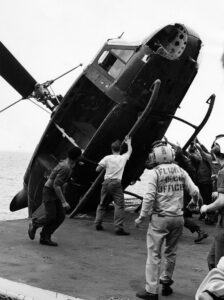
Flight deck of ‘USS Okinawa’ during the evacuation of Saigon, April 1975. Courtesy U.S. Marine Corps History website
I am not in the habit of writing paeans to war machines, but the prototype of the UH-1 Huey helicopter flew for the first time 65 years ago this month, and it was a special machine, in war and peace, that far outlasted its maker.
Lawrence Bell was born in 1894, nine years before the Wright brothers made their first brief flights. He would go on to found a company responsible for at least two prop fighters in WWII, the first US jet-powered aircraft, the X-1 (first plane to break the sound barrier in level flight), and some of the earliest helicopter prototypes, going back to 1941. His Bell 47 helicopter was used in the Korean War (and was what you saw in the TV show and movie MASH), and his Huey was seemingly ubiquitous in the Vietnam War, as utility chopper, air ambulance, troop carrier, and eventually as a relatively lightly-armed gunship.
Wikipedia calls the Huey helicopter Bell’s “greatest enduring legacy,” a machine that “became one of the most recognizable aircraft in history.” A US Army Aviation page calls it “the most universal military aircraft of the modern era, serving in all four branches of the American uniformed services and in the armed forces of at least 48 other nations.”
The Huey was as iconic and of the ‘60s as the VW Bug, with its distinctive nose and windscreens, its boxy body, and thin tail boom. It is the Huey we see when we remember the air assault in Apocalypse Now, or film clips of the evacuation of Saigon and choppers being pushed into the sea off the flight deck of USS Okinawa. Like any other machine, it was an amoral tool until used. What we called air superiority and battlefield survivability often meant suffering to other people, many of them innocent bystanders. In the way countries have plots of sovereign soil in other lands, the Huey was a little bit of America, for better and worse, for decades.
It was still at it when I joined the army in the ‘80s, but that was a transitional time for the US military. One of the changes was the replacement of the Huey, in general use, for the Blackhawk helicopter, which now has become its own totem. The Blackhawk is bigger, faster, stronger, and more menacing than the Huey, but there was something elemental about riding in, or rappelling from, the Huey as it hovered in flight. The Blackhawk is a raven; the Huey was a dragonfly.
American veterans still get together online and in person to admire it; they love its distinctive rotor noise, called “the Huey thump,” since it meant help was on the way. (Here is a YouTube video of a Huey starting up and doing a fly-by that has more than three million views.)
Larry Bell died on what is said to be the day that the Huey’s prototype first flew, October 20, 1956. A heavily modified version of the chopper is still produced, and old-school versions continue to fly, around the globe, though in fewer numbers all the time.
